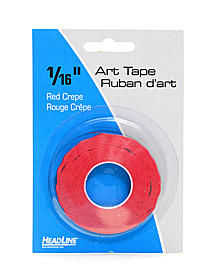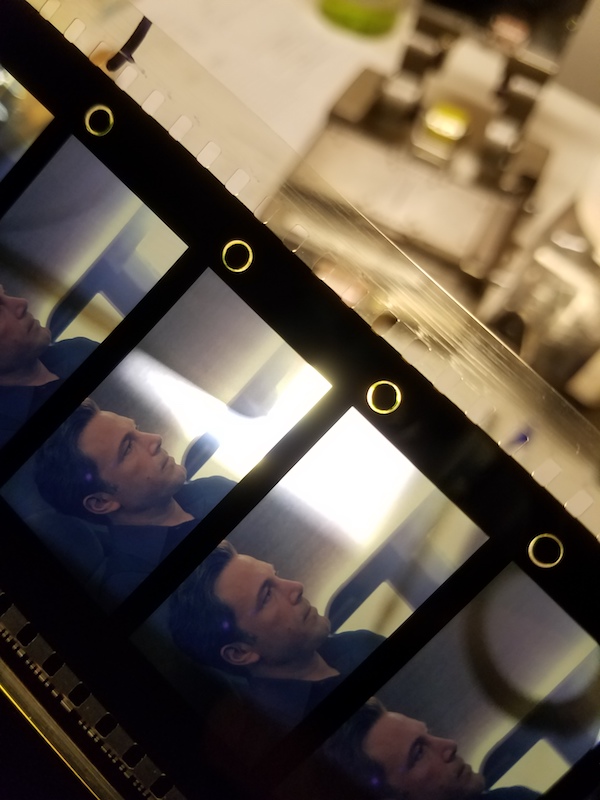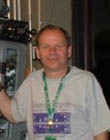|
|
This topic comprises 2 pages: 1 2
|
|
Author
|
Topic: Justice League 70mm C/O Cues
|
|
|
|
|
|
|
|
|
|
|
|
|
|
|
Frank Angel
Film God

Posts: 5305
From: Brooklyn NY USA
Registered: Dec 1999
|
 posted 11-16-2017 06:24 AM
posted 11-16-2017 06:24 AM





Well, I must confess, it has always gone very much against my every instinct to mare a pristine print with handmade, scribed cue marks, even when lab cues are missing and even though it is a perfectly acceptable thing to do. Especially after platter operation began to dominate the industry and I KNEW changeover cues were unnecessary in the majority of the houses those prints would play and for the rest of the print's life. We would indeed get many such prints as we played many sneaks and foreign prints that had no lab cues.
So in order for me to not get an involuntary facial twitch for a week caused by having to scratch emulsion off a pristine print and making an irreversible, visible scar in the emulsion that would intrude on everyone who saw that print...forever, I went to another method that I am sure I must have mentioned here in the past. For the youngin's, I will repeat it:
This method not only will create cues that can be removed later for those brothers and sisters who will run this same print on platters, but to the audience, it looks MUCH better than even the neatest scribed cues that are always more distracting than lab cues because they are always brighter than lab cues (emulsion is scratched away) and no matter how neat you think you can make them, even with the scribe tool, they still are "alive" and dance if only around the edges of the circles.
In the booths I have rolls of artist's line tape (black, of course) clicky here: Artists line tape. 
I apply it over the four Motor Start frames and the four Changeover frames. The 1/8 inch width is perfect as it is about the same width as the diameter of the scribed cue. In fact, once I saw how good this looked on the screen compared to emulsion marring cues, I started using it to cover cues on all prints other than those with real lab cues. The "cue lines" as I called them, covered those horrid multiple hand-etched cues made by multiple blind projectionists over the years especially on old prints of classic titles -- you know, the operators who evidently needed an explosion of light to go off in order to notice a cue. I've seen many prints where guys felt they need to use a razor blade to scratch over perfectly good and visible lab cues. WTF?
Anyway, using this black, adhesive-backed artist liner, sometimes to add cues where none exists, but most times just to cover ugly, distracting, dancing circles etched on top of more circles. The beauty is, what this cue method looks like on the screen to the audience is simply that for those fractions of a second, the image gets a wee-bit narrower -- like a lab masking issue; no question it's MUCH less intrusive, yet still does the job very effectively -- it's visible, it's black not white, and it covers a multitude of sins. It is so neat that it truly looks like something a lab did, not a human hand having at and scarring the emulsion. In fact, I had a a few projectionist friends sit down an watch a screening where I had used this method; I didn't mention anything about it and after the show, without me even commenting, a discussion started when one of them asked, "Did you see those strange changeover cues?" I was amused to hear them all trying to figure out what the lab did...was it on purpose or was it an error? One of them actually said he didn't see any chaneover cues at all (of course he was the youngest and only worked platter booths, so he knew what they changeover cues looked like, but since he never had to actually make changeovers, his mind wasn't attentive to them so he totally missed the connection that the frame masking anomalies were changeover cues. All of them thought they were done by the lab.
In my first experiments with covering ugly scribed cues, I tried cutting squares of the line stuff to cover just the circles, but because I could never really get the snippets of material to be exactly the same shape or put the four of them in exactly the same location, while they were black and did cover the dancing scribed circle cues, they themselves looked animated. Simply laying a line down the side of the full four frame was more effective (and much easier). Plus, that line of tape was less likely to come off the film than multiple small bits of material. BTW, the adhesive backing was so good that in all the years I have been using it, none have ever come off the prints. That said, it could easily be pulled off in a platter booth operator cared to, although I don't think the splice jockeys would be that conscientious.
I have also used the thinner, 1/16in width material to cover those diagonal scratches that some Neanderthals would scratch across entire frames, you know, in case they miss the circle. Sure, the audience does see the black lines, but no question, they are a lot less intrusive and less jarring than what white emulsion scratches look like to the audience.
And yes, Bobby, I get the nostalgia thing that those of us of a certain age have for what we have been seeing since childhood every time we saw a movie, (change-over cues), but still, that's just us. And as much as I can romanticize with the best of them over the "film look," I will readily admit that a lot of it is totally subjective -- changeover cues, while they are perfectly comfortable for us, you have to admit, objectively they are superfluous and only an artifact of film that is intrusive.
For those who have grown up in the digital age, to them, cues add nothing positive to the viewing experience and more than likely are seen as just distracting and another reason for them to claim that digital is "cleaner than film and has no scratches or whatever those stupid circles are in the corner" as I heard someone once argue. Sure, cues marks are synonymous with film, but even I have been covering them up for decades!
| IP: Logged
|
|
|
|
|
|
|
|
|
|
|
|
Leo Enticknap
Film God

Posts: 7474
From: Loma Linda, CA
Registered: Jul 2000
|
 posted 11-17-2017 07:59 AM
posted 11-17-2017 07:59 AM





Yes, those cues were done with a 70mm Clint Phare scriber. We had one at my last workplace.
FotoKem normally do excellent work, but changeover cues seem to be their Achilles' Heel. I've had at least three (that I can remember) 35mm 1.85 hard matted prints in which the film was placed in the wrong pins of the scriber, resulting in cues on the black matte above the frame (and thus invisible).
quote: Steve Roberts
This is one of the ONLY occasion when a projectionist should add new cue's using a black marker pen to make a SMALL cue dot.
This way they can be removed at the end of the run
Black marker pen? Firstly, it'll be nearly invisible on a dark scene, and secondly, if the marker ink is not water-based, it won't come off at all. And if you mark the emulsion side, it certainly won't come off, whatever the dye is made of (because the emulsion will absorb it).
Unless there's a strong argument against it (e.g. the booth is very noisy), I would always prefer click strips using good quality splicing tape than marking the print. That's as near to 100% guaranteed as you'll ever get that the cues can be removed without a trace.
| IP: Logged
|
|
|
|
|
|
All times are Central (GMT -6:00)
|
This topic comprises 2 pages: 1 2
|
Powered by Infopop Corporation
UBB.classicTM
6.3.1.2
The Film-Tech Forums are designed for various members related to the cinema industry to express their opinions, viewpoints and testimonials on various products, services and events based upon speculation, personal knowledge and factual information through use, therefore all views represented here allow no liability upon the publishers of this web site and the owners of said views assume no liability for any ill will resulting from these postings. The posts made here are for educational as well as entertainment purposes and as such anyone viewing this portion of the website must accept these views as statements of the author of that opinion
and agrees to release the authors from any and all liability.
|

 Home
Home
 Products
Products
 Store
Store
 Forum
Forum
 Warehouse
Warehouse
 Contact Us
Contact Us




 Printer-friendly view of this topic
Printer-friendly view of this topic






![[Razz]](tongue.gif)


![[Confused]](confused.gif)

![[beer]](graemlins/beer.gif)











